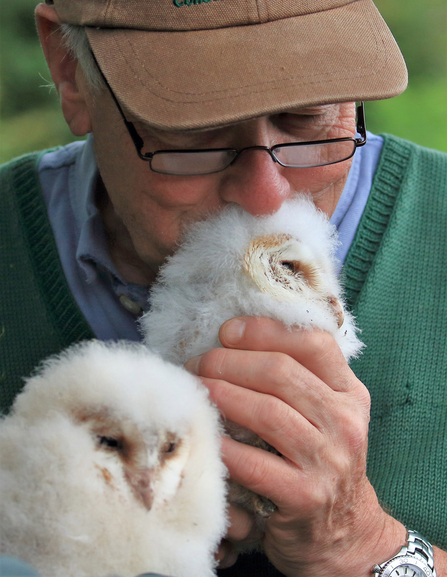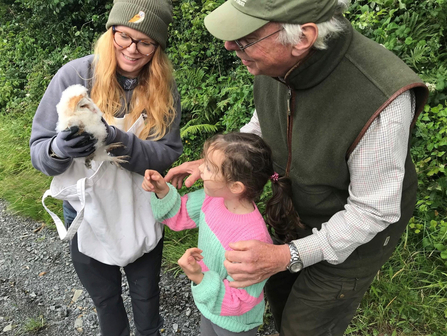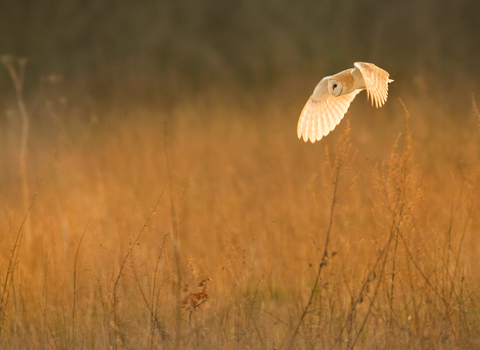
David was overjoyed when the first barn owls bred on his farm in 2019 after patiently waiting for four years for a pair to take up residence in a nest box installed by Ulster Wildlife in 2016.
David Sandford standing beside one of the many barn owl nest boxes erected on his farm by Ulster Wildlife to provide a safe nesting and roosting place for these vulnerable birds

David was overjoyed when the first barn owls bred on his farm in 2019 after patiently waiting for four years for a pair to take up residence in a nest box installed by Ulster Wildlife in 2016.
Join today and help barn owls thrive
With fewer than 30 breeding pairs of barn owls estimated to remain in Northern Ireland, his farm now stands as one of the most successful breeding sites in Northern Ireland for these vulnerable birds.
The journey began a decade ago when David encountered a barn owl during an evening walk across his fields – the first time he’d seen one in over 30 years. Intrigued that the birds might be breeding nearby, he reached out to Ulster Wildlife to install some nest boxes to compliment the nature-rich habitats he had created. Four years of patience and perseverance finally paid off in 2019, when a pair of barn owls took up residence.
“At first, nothing seemed to happen," recalls David, "until four years later my late wife Alison and I saw a pair one evening on our driveway near one of the boxes – we were thrilled! Shortly after, we heard loud snoring noises and screeches from the chicks begging to be fed.”
Six years later, David's 185-acre productive yet nature-rich arable farm has provided a home for 15 owlets, and a host of other dwindling farmland wildlife such as yellowhammer and Irish hare, with support from local nature conservation charities Ulster Wildlife and RSPBNI.
Carefully crafted habitats such as rough grass margins, uncultivated stubbles, dense hedgerows and woodland provide a steady supply of prey such as mice, pygmy shrews and young rats to feed hungry owls, year-round.
Grain feeders kept going all year round, away from farm buildings, also ensure the survival of these magnificent birds by attracting rodents – a “negligible cost”, David said compared to the satisfaction and enjoyment of helping this endangered species.
Knowing that we have provided a safe and productive home for barn owls is a huge privilege and a barometer that we are doing some things right on our farm
“Knowing that we have provided a safe and productive home for barn owls is a huge privilege and a barometer that we are doing some things right on our farm,” he remarked.
Nine nest boxes have been erected to provide a network of safe places for the birds to nest and roost, given the loss of natural nest sites from the countryside, such as tree cavities.
Nest cameras installed last year revealed more about the owls’ secret lives, showcasing their relentless hunting skills and vital role as farm pest controllers.
One of David’s most memorable moments was witnessing fledgling owls honing their hunting techniques.
"Seeing them at such close quarters jumping on and off a round straw bale into the stubble, time and time again, was really special," he recalls.
"It was a perfecting of a method that their very survival would shortly depend upon when left to their own devices by their parents."

Sadly, barn owl populations have plummeted in the UK and Ireland over the past century due to agricultural intensification, habitat loss, a lack of nest sites and increased use of rodenticides (rat poisons).
Katy Bell, Senior Conservation Officer at Ulster Wildlife, works closely with farmers and landowners to help reverse the decline of these iconic birds – from providing advice on wildlife-friendly farming practices to erecting and monitoring nest boxes in suitable locations.
She commended David's passion and dedication to securing the future of the barn owl, emphasising the vital role farmers play in helping nature recover, given the right support.
Nature is in trouble across Northern Ireland, with one in nine species at risk of extinction, but farmers can be part of the solution
“Nature is in trouble across Northern Ireland, with one in nine species at risk of extinction, but farmers can be part of the solution,” said Katy.
“David’s farm shows how targeted management options such as wild bird cover and winter stubble, delivered through agri-environment schemes, have been effective in helping barn owls by ensuring a year-round supply of food. Alongside a network of safe nesting sites, barn owls are thriving on his farm, making it the most successful breeding site in Northern Ireland.”
“The recovery of local wildlife depends on proactive measures like these,” she emphasised.
Barn owl chicks at David Sandford's farm (https://youtu.be/Cj09KzTa07U)
Barn owl chicks at David Sandford's farm - June 2023
The cessation of the Environmental Farming Scheme (Wider) scheme last year and no replacement yet in sight has created a gap in the successful delivery of on-farm measures for wildlife.
Looking ahead, David would like to see future agri-environment schemes strengthened, properly funded, and more accessible to help farmers in their conservation efforts for barn owls and other wildlife.
“Leaving farmers high and dry with no support for the majority of farmland in Northern Ireland is highly regrettable,” he said.
Wildlife is not something that can be turned off and on like a tap; however, given the chance it is remarkably resilient and with the right habitats and long-term support, farmers can really make a difference
“Wildlife is not something that can be turned off and on like a tap; however, given the chance it is remarkably resilient and with the right habitats and long-term support, farmers can really make a difference.”
If you have land suitable for barn owls and would like advice on how to create wildlife-friendly habitats, download our 'Land Management Guidance for Barn Owls' leaflet.
If you have seen a barn owl or would like to discuss measures you can put in place to help them, contact Katy Bell, Ulster Wildlife at barnowls@ulsterwildlife.org or visit our dedicated webpage.
-ENDs-

Jon Hawkins - Surrey Hills Photography